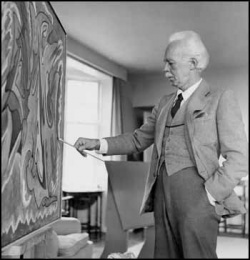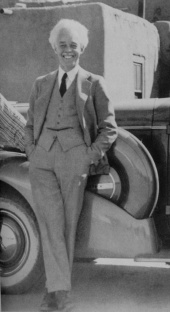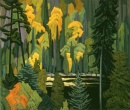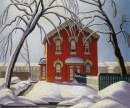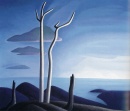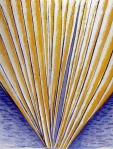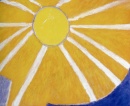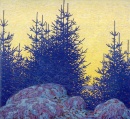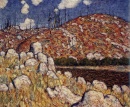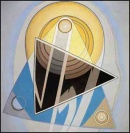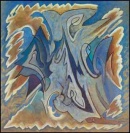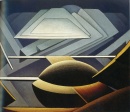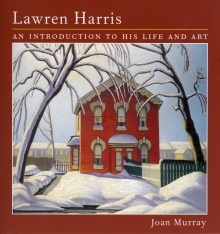Lawren Stewart Harris: Difference between revisions
No edit summary |
No edit summary |
||
| (17 intermediate revisions by 2 users not shown) | |||
| Line 1: | Line 1: | ||
[[File:Lawren Stewart Harris.jpg|right|250px|thumb|Lawren Stewart Harris with ''Biomorphic Composition'']] | |||
[[File:Harris in Santa Fe 1939.jpg|right|170px|thumb|Harris in Santa Fe, 1939]] | |||
[[File:Lawren Stewart Harris.jpg|right|250px| | |||
[[File:Harris | |||
'''Lawren Stewart Harris''', ([[October 23]], 1885 – [[January 29]], 1970) was a Canadian painter, best known as a member the '''Group of Seven''' who pioneered a distinctly Canadian painting style in the early twentieth century. He was a member of the Toronto Lodge of the Theosophical Society in Canada. | '''Lawren Stewart Harris''', ([[October 23]], 1885 – [[January 29]], 1970) was a Canadian painter, best known as a member the '''Group of Seven''' who pioneered a distinctly Canadian painting style in the early twentieth century. He was a member of the Toronto Lodge of the Theosophical Society in Canada. | ||
== | == Involvement with the Theosophical Society == | ||
===Articles=== | |||
<blockquote> | |||
Harris deeply believed in theosophy, to such an extent that he wrote for [[The Canadian Theosophist (periodical)|''The Canadian Theosophist'']], read papers at conventions, and gave radio talks on the subject. He bothered his friends by zealously handing out or sending them literature about the society... In contrast with the religions in which Harris had been raised, theosophy subscribes to no creed or dogma. It therefore took him above ordinary laws, moral codes, and ethical systems – and gave him greater freedom. Moreover, his passionately held belief had a surprisingly invigorating effect on his life and work: theosophy aims its lessons precisely at self-development. It helped Harris to change his life and to become an abstract artist, as he did in 1934. Once he discovered this new orientation, which meant a profound change in his art practice, theosophy helped him stay committed to creating the abstract paintings – which he described as "purer creative work" – that the painted for the remainder of his life.<ref>Joan Murray, ''Lawren Harris: An Introduction to His Life and Art'' (Toronto: Firefly Books, Ltd., 2003), 41.</ref> | |||
</blockquote> | |||
== Artistic career == | |||
Biographer Joan Murray wrote about Harris's legacy in art: | |||
<blockquote> | |||
Lawren Harris was exceptional among major artists in at least three ways. He was born to wealth and never lacked for money. He was an intellectual who theorized about art and demonstrated his theories in his paintings. And he was a spiritual man for all his life, ultimately placing his spiritual ideas at the centre of his art. | |||
Lawren Harris' long quest was for a style in which the demands of both spiritual life and art might be given their due. His legacy lies in his expression of the heart of Canada during a particular period and the breadth of effects he extracted form a medium that he defined broadly and inventively. He was versatile, developing from representation – particularly of landscape – to abstraction.<ref>Joan Murray, 55.</ref> | |||
</blockquote> | |||
He was a member of the famous Group of Seven, along with Franklin Carmichael, Frank Johnston, A. Y Jackson, Arthur Lismer, J. E. H. MacDonald, and F. H. Varley. It expanded into the Canadian Group of Painters in the 1930s, with Harris as president. | |||
=== Gallery === | |||
<gallery widths="130px" heights="150px" perrow="6"> | |||
File:Harris Agawa River Algoma.jpg|''Agawa River, Algoma'' | |||
File:Harris Red House, Winter 1925.jpg|''Red House, Winter'', 1925 | |||
File:Harris Lake Superior, 1928.jpg|''Lake Superior'', 1928 | |||
File:Harris Isolation Peak, 1930.jpg|''Isolation Peak'', 1930 | |||
File:Harris Untitled Abstraction K, 1964.jpg|''Untitled Abstraction "K"'' | |||
File:Harris Untitled Abstraction P, 1968.jpg|''Untitled Abstraction "P"'', 1968 | |||
File:Harris Decorative Landscape 1917.jpg|''Decorative Landscape'', 1917 | |||
File:Harris Laurentian Landscape 1913-14.jpg|''Laurentian Landscape 1913-1914'' | |||
File:Harris - Atma Buddhi Manas.jpeg|''Atma Buddhi Manas'' | |||
File:Harris - Biometric Composition.jpg|''Biometric Composition'', 1938 | |||
File:Harris - Biomorphic Composition.jpg|''Biomorphic Composition'', 1956 | |||
File:Harris Riven Earth I Composition 8, 1936.jpg|''Riven Earth (Composition 8)'', 1936 | |||
</gallery> | |||
[[File:Lawren Harris bio.jpg|right|220px|thumb|Joan Murray biography]] | |||
== Additional resources == | |||
=== Books === | |||
Murray, Joan. ''Lawren Harris: An Introduction to His Life and Art''. Toronto: Firefly Books, Ltd., 2003. | |||
=== Articles === | |||
*[http://www.theosophyforward.com/theosophy-and-the-society-in-the-public-eye/180-lawren-harris-and-theosophy-part-one# Lawren Harris and Theosophy – Part One] and [http://www.theosophyforward.com/theosophy-and-the-society-in-the-public-eye/216-lawren-harris-and-theosophy-part-two-# Part Two] at Theosophy Forward | *[http://www.theosophyforward.com/theosophy-and-the-society-in-the-public-eye/180-lawren-harris-and-theosophy-part-one# Lawren Harris and Theosophy – Part One] and [http://www.theosophyforward.com/theosophy-and-the-society-in-the-public-eye/216-lawren-harris-and-theosophy-part-two-# Part Two] at Theosophy Forward | ||
* Laurence, Robin. "Lawren Harris retrospective chronicles a long, varied journey" at [http://www.straight.com/arts/604856/lawren-harris-retrospective-chronicles-long-varied-journey The Georgia Straight]. March 11, 2014. Accessed November 2,2016. | * Laurence, Robin. "Lawren Harris retrospective chronicles a long, varied journey" at [http://www.straight.com/arts/604856/lawren-harris-retrospective-chronicles-long-varied-journey The Georgia Straight]. March 11, 2014. Accessed November 2,2016. | ||
| Line 18: | Line 53: | ||
[[Category:Nationality Canadian|Harris, Lawren]] | [[Category:Nationality Canadian|Harris, Lawren]] | ||
[[Category:Famous people|Harris, Lawren]] | [[Category:Famous people|Harris, Lawren]] | ||
[[Category:People|Harris, Lawren]] | |||
Latest revision as of 20:54, 21 June 2023
Lawren Stewart Harris, (October 23, 1885 – January 29, 1970) was a Canadian painter, best known as a member the Group of Seven who pioneered a distinctly Canadian painting style in the early twentieth century. He was a member of the Toronto Lodge of the Theosophical Society in Canada.
Involvement with the Theosophical Society
Harris deeply believed in theosophy, to such an extent that he wrote for The Canadian Theosophist, read papers at conventions, and gave radio talks on the subject. He bothered his friends by zealously handing out or sending them literature about the society... In contrast with the religions in which Harris had been raised, theosophy subscribes to no creed or dogma. It therefore took him above ordinary laws, moral codes, and ethical systems – and gave him greater freedom. Moreover, his passionately held belief had a surprisingly invigorating effect on his life and work: theosophy aims its lessons precisely at self-development. It helped Harris to change his life and to become an abstract artist, as he did in 1934. Once he discovered this new orientation, which meant a profound change in his art practice, theosophy helped him stay committed to creating the abstract paintings – which he described as "purer creative work" – that the painted for the remainder of his life.[1]
Artistic career
Biographer Joan Murray wrote about Harris's legacy in art:
Lawren Harris was exceptional among major artists in at least three ways. He was born to wealth and never lacked for money. He was an intellectual who theorized about art and demonstrated his theories in his paintings. And he was a spiritual man for all his life, ultimately placing his spiritual ideas at the centre of his art.
Lawren Harris' long quest was for a style in which the demands of both spiritual life and art might be given their due. His legacy lies in his expression of the heart of Canada during a particular period and the breadth of effects he extracted form a medium that he defined broadly and inventively. He was versatile, developing from representation – particularly of landscape – to abstraction.[2]
He was a member of the famous Group of Seven, along with Franklin Carmichael, Frank Johnston, A. Y Jackson, Arthur Lismer, J. E. H. MacDonald, and F. H. Varley. It expanded into the Canadian Group of Painters in the 1930s, with Harris as president.
Gallery
Additional resources
Books
Murray, Joan. Lawren Harris: An Introduction to His Life and Art. Toronto: Firefly Books, Ltd., 2003.
Articles
- Lawren Harris and Theosophy – Part One and Part Two at Theosophy Forward
- Laurence, Robin. "Lawren Harris retrospective chronicles a long, varied journey" at The Georgia Straight. March 11, 2014. Accessed November 2,2016.
